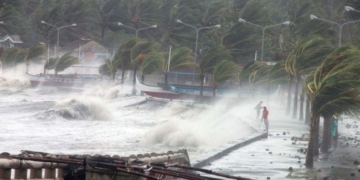“Zoe” is the new name given to the heatwave that has struck Seville, Spain, over the past week – marking the first heatwave in the world to be named.
This heatwave has pushed temperatures above 43 degrees Celsius, becoming the most extreme heatwave in the new ranking system for heatwaves in this city.
The “Zoe” heatwave has brought scorching temperatures to the southern region of Spain in recent days, particularly affecting Andalusia and Seville. Even after nightfall, when the human body relies on cooler nighttime weather to recover from the daytime heat, the heat shows little sign of abating.

Severe heat returned at the beginning of this month. Cities across Spain have broken monthly temperature records, and wildfires have erupted in many areas.
Zoe is the first named heatwave to hit Seville since the city officially launched a new experimental program in June 2022, which names and ranks heatwaves similar to how storms are currently monitored.
Only the most extreme heatwaves are named in reverse alphabetical order. After Zoe will come Yago, Xenia, Wenceslao, and Vega.
According to proMETEO Sevilla, the new heatwave ranking system in Seville, prolonged high temperatures have posed significant risks to human health.
ProMETEO Sevilla is a collaborative agency between the city of Seville and the recovery center of the Adrienne Arsht-Rockefeller Foundation within the Atlantic Council (Arsht-Rock), along with other partners including the Spanish Office for Climate Change and several universities and research institutes in Spain. Members have established three levels to classify heatwaves in Seville, where level 1 is the lowest rank and level 3 is the most severe.
The system has specific criteria for each category, not only related to daytime temperatures but also nighttime lows, humidity, and the expected impact of heat on human health. Each level triggers a set of emergency response activities, such as issuing weather alerts, opening cooling centers, and deploying community medical teams to check on vulnerable populations.
Spain has struggled with extreme temperatures throughout the past summer. According to the Spanish Meteorological Agency, high temperatures set records across all regions of the country last month, and the first two weeks of June 2022 marked the hottest recorded period nationwide.
Broader across the continent, this June has been recorded as the second hottest June in Europe according to the Copernicus Climate Change Service of the European Union.
Severe heat returned at the beginning of this month. Cities throughout Spain have broken monthly temperature records, and wildfires have erupted in many areas.
The record-high temperatures have also affected other regions of Western Europe, where heatwaves are intensifying four times faster than in other areas with average temperatures. Temperatures in the United Kingdom soared above 40 degrees Celsius, breaking the country’s all-time temperature record multiple times in a single day.
Climate change is causing heatwaves to become more frequent, intense, and prolonged worldwide, increasing risks to human health.
The new ranking and naming system in Seville aims to raise community awareness about the dangers of extreme temperatures. This is currently the only system with a naming component. Other cities are following suit with similar ranking programs. Athens, Greece, recently announced a new system to classify heatwaves, while several cities across the United States are implementing their own pilot programs, including Los Angeles, Miami, Milwaukee, and Kansas…


















































